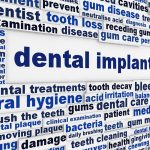
The Nobel Biocare websites states “All-on-4® treatment Concept: A minimally invasive solution with a fixed full-arch restoration for high patient satisfaction. In 1998 Dr Paulo Malo successfully treated the first patient with the All-on-4® treatment concept. Since then hundreds of thousands of patients have been treated with this concept using Nobel Biocare implants. The All-on-4® treatment concept is the best solution for full-arch treatment using tilted implants. But only when Nobel Biocare products are combined. Many have tried to mirror this ground-breaking concept, but only we have the scientifically documented success to back it up.”(NobelBiocare 2016).
The objective of the authors was to systematically review the literature on the All-on-4® (Ao4) treatment concept regarding its indications, surgical procedures, prosthetic protocols, technical and biological complications after at least three years in function.(Soto-Penaloza et al. 2017)
Methods
The review followed the PRISMA statement. Searches were conducted by two independent reviewers using MEDLINE (via PubMed), EMBASE, and the Cochrane Library of the Cochrane Collaboration (CENTRAL). This was supplemented with grey literature via Open Grey . The dates were limited to January 2005 – April 2016 with no language restriction. Eligibility criteria were systematic reviews, randomized clinical trials, controlled clinical trials, prospective and retrospective cohort studies and case series; only studies involving human individuals, aimed at showing efficacy of the all-on-four treatment concept, including ≥ 10 patients, with a minimum follow-up of three years, and reporting data related to treatment indication, surgical procedures, prosthetic protocols and complications (prosthetic and biological) associated to the all-on-four protocol. Two reviewers independently selected studies for inclusion, abstracted data and assessed risk of bias using a modified version of the Cochrane Collaboration tool for assessing risk of bias (Higgins JPT et al. 2011) for the randomised control trial , and the Newcastle-Ottawa Scale for the non-randomised studies. The authors cited three outcome criteria:
- Treatment indications, surgical procedures, prosthetic protocols (loading time, prosthetic material, abutment, type of fixation, occlusal control).
- Technical complications (prosthesis fracture, abutment fracture, screw fracture or losses).
- Biological complications (mucositis, peri-implantitis, implant failure).
Results
- 24 studies fulfilled the inclusion criteria (1 randomised control trial, 9 prospective studies, 14 retrospective studies and 7 case series.
- According to the authors assessment 13 studies were at high risk of bias and 11 at low risk of bias.
- A total of 1963 patients received 11,743 implants, no mean follow-up time or number of prosthesis were specified.
Primary outcome
- This was presented as a narrative review showing the wide variability in inclusion criteria, surgical techniques, and prosthetic protocol while remaining within the Ao4 concept guidance protocol and products.
- The most common prosthetic complication was fracture of the acrylic prosthesis. 23.2% of patients had a breakage of the definitive prosthesis.
- An implant survival rate at 24 months of 99.8%.
Conclusion
The author concluded:-
The all-on-four treatment concept offers a predictable way to treat the atrophic jaw in patients that do not prefer regenerative procedures, which increase morbidity and the treatment fees. The results obtained indicate a survival rate for more than 24 months of 99.8%. However, current evidence is limited due the scarcity of information referred to methodological quality, a lack of adequate follow-up, and sample attrition. Biological complications (e.g., peri-implantitis) are reported in few patients after a mean follow-up of two years. Adequate definition of the success / survival criteria is thus necessary, due the high prevalence of peri-implant diseases.
Comments
This comprehensive review looked at large volume of data concerning the Ao4 concept, but as the author points out in the conclusion there is also a lack of reproducible data to make high quality quantitative conclusions with. One concern was that several papers exhibited conflicts of interest with Nobel Biocare which were not disclosed in the literature. A second concern that needed investigating was the mention of a survival rate for more than 24 months of 99.8%, which seemed too good to be true. I therefore spent a bit of time doing a sensitivity analysis by filtering their reviews. I excluded all the papers that were retrospective, were at high risk of bias and less than 5-years follow-up and I reviewed the full-text primary research papers that remained. This immediately shrank the eligible studies from 24 down to 6 and then eventually to 2 papers (Cavalli et al. 2012; Lopes et al. 2015).
From the 60-month survival data and imputing the missing data results the best-case survival at five years /implant was 97% (95% CI: 94 to 100) and at worst 86% (95% CI: 79 to 93). The authors offered no figures on peri-implantitis incidence or prevalence but the latest paper from the University Hospital Ghent (Browaeys et al. 2015) concluded that after examining 80 implants placed using the Ao4 concept, after 3 years 49.2% had an unacceptable ongoing bone loss. It is important that researches make use of their quality and risk of bias assessments when undertaking SRs and follow up on missing data.
Links
Primary paper
Soto-Penaloza, D. et al., 2017. The all-on-four treatment concept: Systematic review. Journal of Clinical and Experimental Dentistry, 9(3), pp.0–0.
Other references
Browaeys, H. et al., 2015. Ongoing Crestal Bone Loss around Implants Subjected to Computer-Guided Flapless Surgery and Immediate Loading Using the All-on-4?? Concept. Clinical Implant Dentistry and Related Research, 17(5), pp.831–843.
Cavalli, N. et al., 2012. Tilted implants for full-arch rehabilitations in completely edentulous maxilla: A retrospective study. International Journal of Dentistry, 2012.
Higgins JPT et al., 2011. The Cochrane Collaboration’s tool for assessing risk of bias in randomised trials. British Medical Journal, 343, pp.889–893.
Lopes, A. et al., 2015. The NobelGuide All-on-4 Treatment Concept for Rehabilitation of Edentulous Jaws: A Prospective Report on Medium- and Long-Term Outcomes. Clinical Implant Dentistry and Related Research, pp.e406–e416.
NobelBiocare, 2016. All-on-4. Nobel Biocare Services AG.

[…] All-on-4 treatment concept, the latest systematic review […]
[…] ‘All-on-4®’ treatment concept: current evidence limited […]